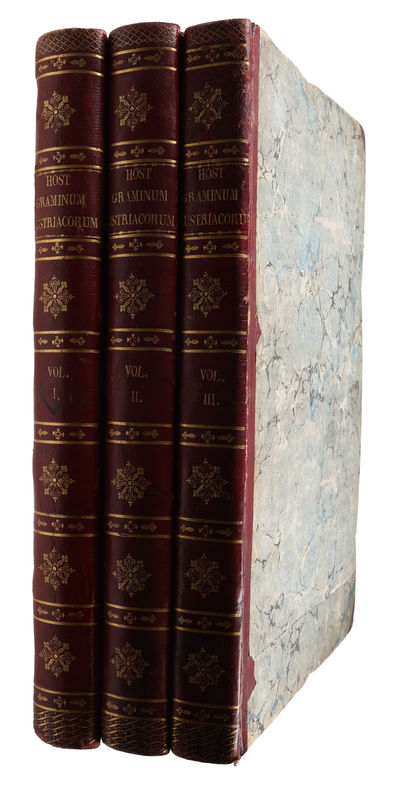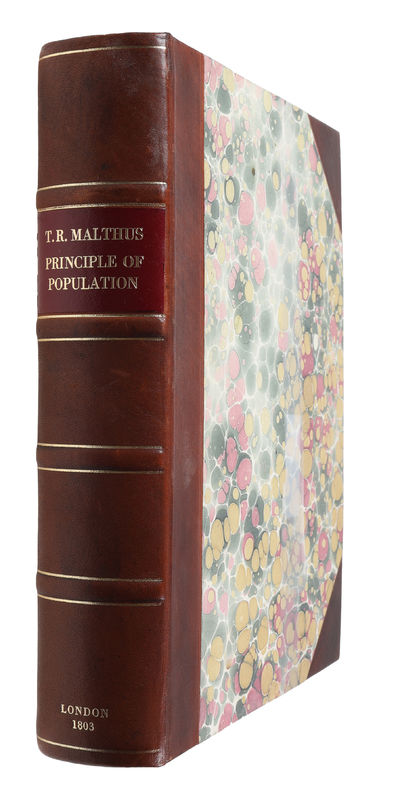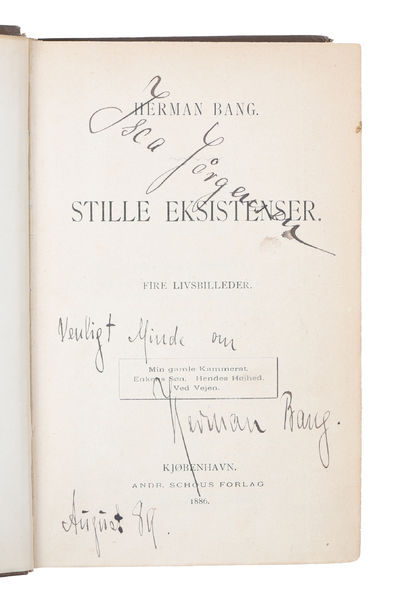BURNETT, M.A.
Plantæ Utiliores; or Illustration of Useful Plants, Employed in the Arts and Medicine. 4 vols. - [SCARCE COMPLETE SET OF MISS BURNETT'S STUNNING MEDICINAL PLANTS]
Herman H. J. Lynge & Søn A/S
lyn62797
London, Whittaker & Co. 1842-1850. Large 4to. Bound in four beautiful, contemporary, uniform black full calf bindings with richly gilt spines, gilt red leather title-labels, and five raised bands, also gilt. Gilt double line borders to boards, all edges of boards gilt, and inner blindstamped dentelles. All edges gilt. Spines with some wear, corners slightly bumped, and some overall signs of use. Front hinge of vol. four professionally restored with black morocco. A lovely set. Vol. I: (26) pp. (being title-page + Subsribers List), 6 ff. of index (later, machine-written, and inserted between the Subscibers List and the first plate) + 60 plates, all plates accompanied by text, between 1 and 3 ff. for each; Vol II:title-page, 68 plates, accompanied by 2 pp. of text for each; Vol III: title-page, dedication-leaf, and 64 plates, each accompanied by a leaf of text; Vol. IV: Title-page + 68 plates, each accompanied by two pp. of text. Text-leaves unnumbered. Most plates numbered in pencil in upper right corner. A wonderful, fresh, and clean copy with all 260 fine hand-colored lithographed plates, with practically no offsetting or foxing, all with tissue guards. With a gift-bookplate from Mary C. L. Williams to Margaret Anne Hussey, dated 1915, to all four volumes. (Chabot's Zinc, Skinner st.).
First and only edition of this beautiful book of medicinal plants, with 260 magnificent plates my Miss M. A. Burnett in stunning hand-colouring. Mary Ann Burnett was one of the foremost femaile Victorian-era botanists, as well as author, and illustrator. She is primarily famous for her stunning botanical artwork, most natable of which is the grand four-volume Plantae Utiliores. The 260 plates in this wonderful work are known for their scientific precision as well as their beauty and vibrant colours. This Victorian-era work of medicinal plants with its scientific descriptions and accounts of the medicinal and culinary uses of the plants brings to mind the herbals of preceding centuries, but has a rare artistic appeal - and is the work of a female artist and scientist. Part of the text is by botanist Gilbert Thomas Burnett, Miss Burnett's brother. The work is rarely found in coplete state as here. BMC NH. Vol. 1, p.291. has only 130 plates. Nissen; 305; Pritzel 1400. "Most of the text was drawn from notes left by Miss Burnett's brother G.T.B." (The Library of the Stiftung fur Botanik, Liechtenstein. Sotheby's Sales Catalogue. 1975. No. 118). Sitwell: p. 83.
First and only edition of this beautiful book of medicinal plants, with 260 magnificent plates my Miss M. A. Burnett in stunning hand-colouring. Mary Ann Burnett was one of the foremost femaile Victorian-era botanists, as well as author, and illustrator. She is primarily famous for her stunning botanical artwork, most natable of which is the grand four-volume Plantae Utiliores. The 260 plates in this wonderful work are known for their scientific precision as well as their beauty and vibrant colours. This Victorian-era work of medicinal plants with its scientific descriptions and accounts of the medicinal and culinary uses of the plants brings to mind the herbals of preceding centuries, but has a rare artistic appeal - and is the work of a female artist and scientist. Part of the text is by botanist Gilbert Thomas Burnett, Miss Burnett's brother. The work is rarely found in coplete state as here. BMC NH. Vol. 1, p.291. has only 130 plates. Nissen; 305; Pritzel 1400. "Most of the text was drawn from notes left by Miss Burnett's brother G.T.B." (The Library of the Stiftung fur Botanik, Liechtenstein. Sotheby's Sales Catalogue. 1975. No. 118). Sitwell: p. 83.
Adress:
Silkegade 11
DK-1113 Copenhagen Denmark
Telefon:
CVR/VAT:
DK 16 89 50 16
E-post:
Webb:
![Plantæ Utiliores; or Illustration of Useful Plants, Employed in the Arts and Medicine. 4 vols. - [SCARCE COMPLETE SET OF MISS BURNETT'S STUNNING MEDICINAL PLANTS] (photo 1)](https://d3525k1ryd2155.cloudfront.net/h/362/414/1717414362.0.l.jpg)
![Plantæ Utiliores; or Illustration of Useful Plants, Employed in the Arts and Medicine. 4 vols. - [SCARCE COMPLETE SET OF MISS BURNETT'S STUNNING MEDICINAL PLANTS] (photo 2)](https://d3525k1ryd2155.cloudfront.net/h/362/414/1717414362.1.l.jpg)
![Plantæ Utiliores; or Illustration of Useful Plants, Employed in the Arts and Medicine. 4 vols. - [SCARCE COMPLETE SET OF MISS BURNETT'S STUNNING MEDICINAL PLANTS] (photo 3)](https://d3525k1ryd2155.cloudfront.net/h/362/414/1717414362.2.l.jpg)
![Plantæ Utiliores; or Illustration of Useful Plants, Employed in the Arts and Medicine. 4 vols. - [SCARCE COMPLETE SET OF MISS BURNETT'S STUNNING MEDICINAL PLANTS] (photo 4)](https://d3525k1ryd2155.cloudfront.net/h/362/414/1717414362.3.m.jpg)
![Plantæ Utiliores; or Illustration of Useful Plants, Employed in the Arts and Medicine. 4 vols. - [SCARCE COMPLETE SET OF MISS BURNETT'S STUNNING MEDICINAL PLANTS] (photo 5)](https://d3525k1ryd2155.cloudfront.net/h/362/414/1717414362.4.l.jpg)
![Plantæ Utiliores; or Illustration of Useful Plants, Employed in the Arts and Medicine. 4 vols. - [SCARCE COMPLETE SET OF MISS BURNETT'S STUNNING MEDICINAL PLANTS] (photo 6)](https://d3525k1ryd2155.cloudfront.net/h/362/414/1717414362.5.l.jpg)
![Plantæ Utiliores; or Illustration of Useful Plants, Employed in the Arts and Medicine. 4 vols. - [SCARCE COMPLETE SET OF MISS BURNETT'S STUNNING MEDICINAL PLANTS] (photo 7)](https://d3525k1ryd2155.cloudfront.net/h/362/414/1717414362.6.l.jpg)
![Plantæ Utiliores; or Illustration of Useful Plants, Employed in the Arts and Medicine. 4 vols. - [SCARCE COMPLETE SET OF MISS BURNETT'S STUNNING MEDICINAL PLANTS] (photo 8)](https://d3525k1ryd2155.cloudfront.net/h/362/414/1717414362.7.l.jpg)
![Plantæ Utiliores; or Illustration of Useful Plants, Employed in the Arts and Medicine. 4 vols. - [SCARCE COMPLETE SET OF MISS BURNETT'S STUNNING MEDICINAL PLANTS] (photo 9)](https://d3525k1ryd2155.cloudfront.net/h/362/414/1717414362.8.l.jpg)
![Plantæ Utiliores; or Illustration of Useful Plants, Employed in the Arts and Medicine. 4 vols. - [SCARCE COMPLETE SET OF MISS BURNETT'S STUNNING MEDICINAL PLANTS] (photo 10)](https://d3525k1ryd2155.cloudfront.net/h/362/414/1717414362.9.l.jpg)
![Plantæ Utiliores; or Illustration of Useful Plants, Employed in the Arts and Medicine. 4 vols. - [SCARCE COMPLETE SET OF MISS BURNETT'S STUNNING MEDICINAL PLANTS] (photo 11)](https://d3525k1ryd2155.cloudfront.net/h/362/414/1717414362.10.l.jpg)
![Plantæ Utiliores; or Illustration of Useful Plants, Employed in the Arts and Medicine. 4 vols. - [SCARCE COMPLETE SET OF MISS BURNETT'S STUNNING MEDICINAL PLANTS] (photo 12)](https://d3525k1ryd2155.cloudfront.net/h/362/414/1717414362.11.l.jpg)
![Plantæ Utiliores; or Illustration of Useful Plants, Employed in the Arts and Medicine. 4 vols. - [SCARCE COMPLETE SET OF MISS BURNETT'S STUNNING MEDICINAL PLANTS] (photo 13)](https://d3525k1ryd2155.cloudfront.net/h/362/414/1717414362.12.l.jpg)

![Mikaël. - [DEDIKATIONSEKSEMPLAR.]](https://d3525k1ryd2155.cloudfront.net/h/330/414/1717414330.0.l.jpg)


